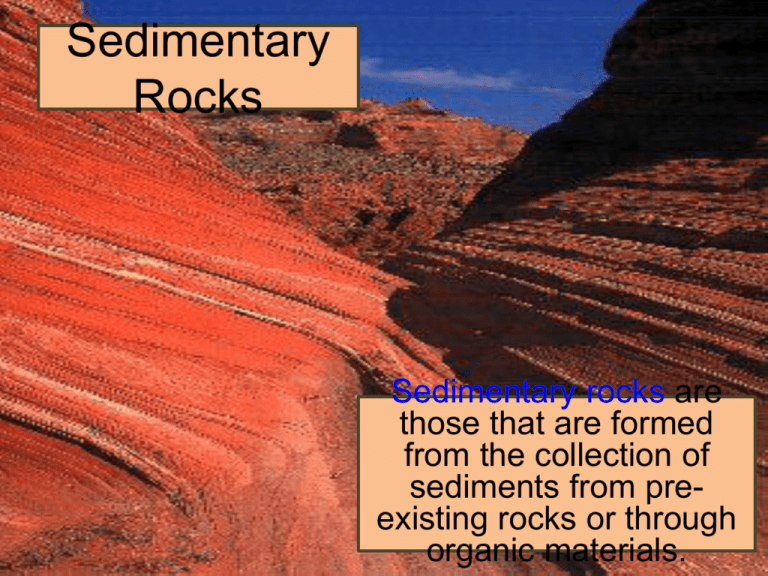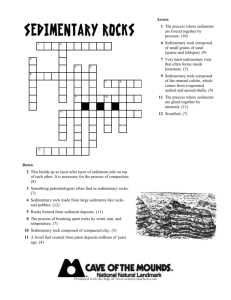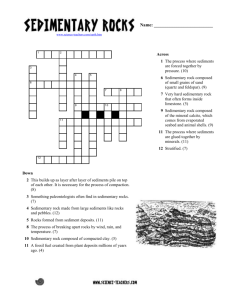Sedimentary Rocks
advertisement

Sedimentary Rocks Sedimentary rocks are those that are formed from the collection of sediments from preexisting rocks or through organic materials. Formation of Sedimentary Rocks Most sedimentary rocks are composed of sediments (sometimes called “clasts”) associated with the weathering of older rock. The sediments that are weathered from older rock are transported to new locations by an erosional agent – like streams or glaciers. Most of these sediments will eventually be deposited as horizontal beds in large bodies of water. Over time, these deposited sediments will transform into sedimentary rock through a number of different processes including: -- COMPACTION -- CEMENTATION -- CHEMICAL ACTION Compaction and Cementation Clastic Sedimentary Rocks Many sediments exposed to movements of the Earth and/or the weight of overlying large bodies of water over long periods of time are “compressed” together – reducing pore space and volume between sediments or clasts. This is known as compaction. Shale is formed from the compaction of clay sediments. Sandstone is formed from the compaction and cementation of sand sediments. Most sediments that experience compaction also experience cementation. Cementation occurs when dissolved minerals in water precipitate in the pore space between sediments “cementing” them together. Chemical Non-Clastic Sedimentary Rocks Action Water at Earth’s surface contains many soluble minerals (minerals dissolved in water). When water evaporates, the minerals in solution will precipitate out as a solid, crystalline form known as an evaporite. Evaporites are composed of one mineral and are non-clastic. Non-clastic sedimentary rocks are rocks that are not made up of “clasts” or sediments. Evaporites are also called chemical sedimentary rock. A B C Examples of chemical sedimentary rocks (evaporites) include: rock salt (A), rock gypsum (B), and dolostone (C). Organic Bioclastic Sedimentary Rocks Processes Some sedimentary rocks are formed from the organic processes of living things. These rocks are often referred to as bioclastic sedimentary rocks. Bioclastic sedimentary rocks are those made by living things or are composed of minerals precipitated out of living things. Bituminous Coal is compacted remains of plants. Fossiliferous Limestone is formed by the compaction and cementation of shell fragments. Distinguishing Features of Sedimentary Rocks 1. Most are clastic. 2. Most are clasts are round. 3. Most clasts are sorted by size. 4. Fossils are found in sedimentary rock. Distinguishing Features of Sedimentary Rocks 5. Most sedimentary rock is arranged in layers. 6. Some sedimentary rock preserves features that may appear in a depositional system (Ex: mud cracks or ripple marks from a stream.). Identifying Sedimentary Rocks RT = Pg. 7 The clasts within a sedimentary rock measure .002 cm in diameter. What is the name of the rock? SILTSTONE








